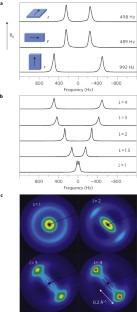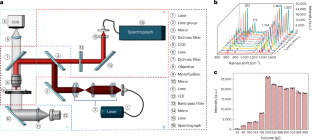2025-04-01 バージニア工科大学(Virginia Tech)
<関連情報>
- https://news.vt.edu/articles/2025/04/science-chemisty-feng-lin-naturenanotechnology25.html
- https://www.nature.com/articles/s41565-025-01885-5
- https://www.nature.com/articles/nmat3048
高電位リチウム電池における電極-多相ポリマー電解質界面の不均一性の影響の解明 Investigating the effect of heterogeneities across the electrode|multiphase polymer electrolyte interfaces in high-potential lithium batteries
Jungki Min,Seong-Min Bak,Yuxin Zhang,Mingyu Yuan,Nicholas F. Pietra,Joshua A. Russell,Zhifei Deng,Dawei Xia,Lei Tao,Yonghua Du,Hui Xiong,Ling Li,Louis A. Madsen &Feng Lin
Nature Communications Published:01 April 2025
DOI:https://doi.org/10.1038/s41565-025-01885-5

Abstract
Polymer electrolytes hold great promise for safe and high-energy batteries comprising solid or semi-solid electrolytes. Multiphase polymer electrolytes, consisting of mobile and rigid phases, exhibit fast ion conduction and desired mechanical properties. However, fundamental challenges exist in understanding and regulating interactions at the electrode|electrolyte interface, especially when using high-potential layered oxide active materials at the positive electrode. Here we demonstrate that depletion of the mobile conductive phase at the interface contributes to battery performance degradation. Molecular ionic composite electrolytes, composed of a rigid-rod ionic polymer with nanometric mobile cations and anions, serve as a multiphase platform to investigate the evolution of ion conductive domains at the interface. Chemical and structural characterizations enable the visualization of concentration heterogeneity and spatially resolve the interfacial chemical states over a statistically significant field of view for buried interfaces. We report that concentration and chemical heterogeneities prevail at electrode|electrolyte interfaces, leading to phase separation in polymer electrolytes. Understanding the hidden roles of interfacial chemomechanics in polymer electrolytes enables us to design an interphase tailoring strategy based on electrolyte additives to mitigate the interfacial heterogeneity and improve battery performance.
高分子電解質膜におけるアライメントと輸送の線形結合 Linear coupling of alignment with transport in a polymer electrolyte membrane
Jing Li,Jong Keun Park,Robert B. Moore & Louis A. Madsen
Nature Materials Published:19 June 2011
DOI:https://doi.org/10.1038/nmat3048

Abstract
Polymer electrolyte membranes (PEMs) selectively transport ions and polar molecules in a robust yet formable solid support. Tailored PEMs allow for devices such as solid-state batteries,‘artificial muscle’ actuators and reverse-osmosis water purifiers. Understanding how PEM structure and morphology relate to mobile species transport presents a challenge for designing next-generation materials. Material length scales from subnanometre1,2 to 1 μm (refs 3, 4) influence bulk properties such as ion conductivity and water transport. Here we employ multi-axis pulsed-field-gradient NMR (ref. 5) to measure diffusion anisotropy, and 2H NMR spectroscopy5,6 and synchrotron small-angle X-ray scattering7 to probe orientational order as a function of water content and of membrane stretching. Strikingly, transport anisotropy linearly depends on the degree of alignment, signifying that membrane stretching affects neither the nanometre-scale channel dimensions nor the defect structure,causing only domain reorientation. The observed reorientation of anisotropic domains without perturbation of the inherent nematic-like domain character parallels the behaviour of nematic elastomers8, promises tailored membrane conduction and potentially allows understanding of tunable shape-memory effects in PEM materials9. This quantitative understanding will drive PEM design efforts towardsoptimal membrane transport, thus enabling more efficient polymeric batteries, fuel cells, mechanical actuators and water purification.



